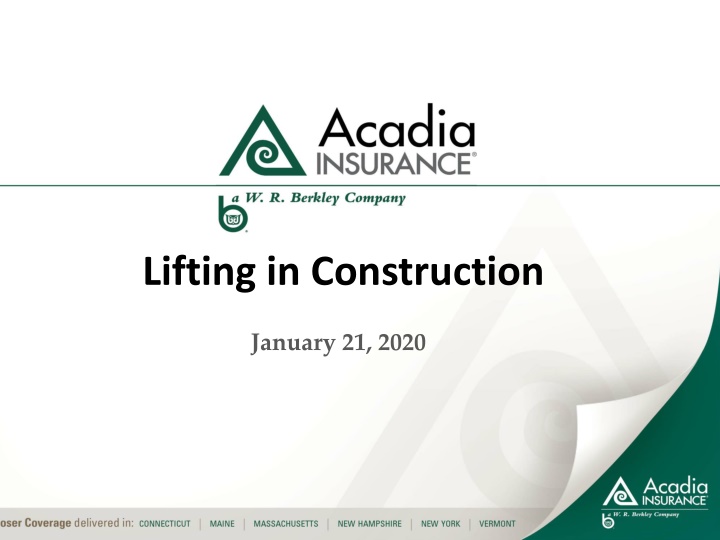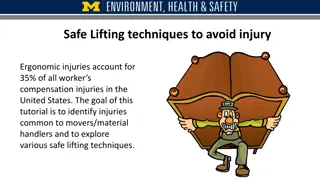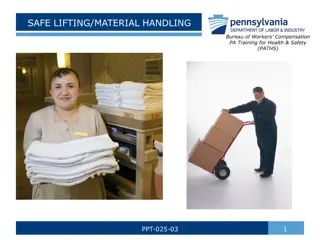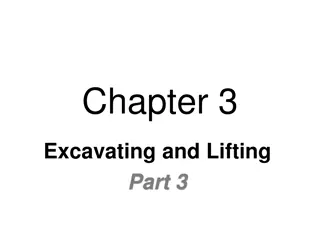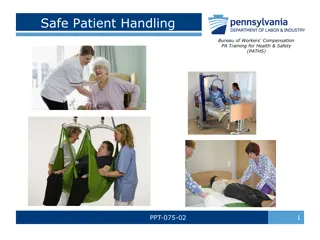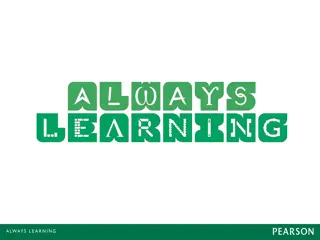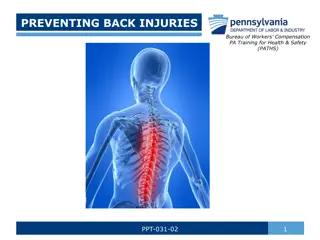Importance of Proper Lifting Techniques in Construction
Learn about the significance of proper lifting procedures in the construction industry, including the risks associated with manual lifting, the costs involved in back injuries, common back issues, and essential principles for safe manual lifting practices. Understanding these key points can help reduce injuries, enhance productivity, and improve the overall well-being of workers.
Download Presentation

Please find below an Image/Link to download the presentation.
The content on the website is provided AS IS for your information and personal use only. It may not be sold, licensed, or shared on other websites without obtaining consent from the author.If you encounter any issues during the download, it is possible that the publisher has removed the file from their server.
You are allowed to download the files provided on this website for personal or commercial use, subject to the condition that they are used lawfully. All files are the property of their respective owners.
The content on the website is provided AS IS for your information and personal use only. It may not be sold, licensed, or shared on other websites without obtaining consent from the author.
E N D
Presentation Transcript
Lifting in Construction January 21, 2020
INTRODUCTIONS Keeny Donohue, Regional Loss Control Director, CT Branch Keeny.Donohue@acadia-ins.com Thank you Kate Morrison & John Able ! Industries here today?
GOALS FOR THIS TRAINING Provide insight as to how big a problem manual lifting is in your industry Briefly review exposures associated with manual lifting Demonstrate proper lifting procedures & show structure of the back Discuss controls that Management can implement towards reducing exposures & costs Provide resources to make it easy for you to build a solid foundation
WHY SHOULD WE CARE ABOUT MANUAL LIFTING IN CONSTRUCTION ? COSTS $$$$$$$ Direct & Indirect Upper Back According to Injury Facts' 2017 data, total costs per claim to the upper back were almost $34,000. Lower Back During the same time frame, workers' comp claims for the lower back amounted to almost $40,000, or higher (average costs). Source: National Safety Council
Why Should we Care? About 80% of adults are estimated to experience a back injury in their lifetime with roughly 10% suffering a re-injury Loss of productivity Injured worker quality of life Can be more prone to another accident
Lifting Exposures Too much weight higher likelihood of an injury. NIOSH Max. weigh is 51 LBs with TWO hands. Frequent improper lifting/repetitive work Repetitive bending, pushing & pulling
THE SPINAL COLUMN . High Risk Area L1 L5 S1
SPINAL DISC DETAIL Disc Soft Center Outer Ring Vertebra
Principles of Manual Lifting Keep load close to your body Get a grip! Lift with your legs Keep load in front of you (nose over toes) Lift with your legs
Does Holding the Load Close really Matter ?
Eliminate & Reduce Plan ahead by discussing daily tasks requiring manual lifting. Rent or purchase Material Handling equipment. Have the supplier place material in the right location. Complete JHA specifically for material handling exposures. Start with the heaviest, most difficult exposures.
Lifting, Holding, and Handling Materials - Deliver Grout Mechanically Deliver grout mechanically instead of with buckets or wheelbarrows
Use Mechanical Equipment for Digging Use a trencher or backhoe for digging trenches
Use Mechanized Equipment to Stage Materials Use a lull or aerial lift to stage materials at high levels or onto the bed of trucks.
Planning - Material Handling Are there heavy materials that will be handled on site? What material handling equipment can be used? Do workers lift more than 50 pounds without help? NIOSH Max. weigh is 51 LBs with 2 hands. Are there handles to help carry materials? Are carts or dollies available? Do any of the job task require lifting overhead or working on items above shoulder height? Where will the materials be staged?
Sample JHA for Manual Lifting Job Hazard Analysis Example: Drywalling Task:Carrying sheets of drywall Hazard: Back & shoulder injuries Protection/Prevention: Have materials delivered to levels by supplier. Anyone working alone will use a panel lifter. Use scaffolding & Use drill extension. Train all drywall workers by 1/20/2020
GROUP ACTIVITY Step 1 each group pick ONE manual lifting task that is of concern (should apply to one of your businesses) due to the weight, frequency of the lifting, or awkward positioning of the body. Step 2 Explain the task & what your concerns are so your group clearly gains a perspective. Step 3 Who will write? Pick a person in your group to fill in the Job Safety Analysis form. Person should have clear handwriting if possible. Step 4 - discuss each section starting with writing the specific task, hazards/concerns with this task, then finally brainstorm ideas on controls that could help eliminate, reduce, or improve this exposure. Step 5 Who will speak? Decide which person in your group will share your Job Safety Analysis (JHA) back to the room.
Management Controls Strong hiring practices to include drug testing especially for safety sensitive positions Physical capacity evaluations based on job description @ occupational clinic Manual lifting JHAs Supervision & accountability Orientation training & on-going training (note: 60% of construction injuries happen within employee s first year of employment.) Source: Bureau of labor statistics Investigations of all accidents Stretching program (refer to resource link).
Resources https://www.mazzottarentals.com/equipment- rentals.asp?customer=
Resources https://ohsonline.com/articles/2017/02/01/workpl ace-stretching-programs.aspx https://www.oshatraining.com/Toolbox-Talks.php https://www.cdc.gov/niosh/docs/2013- 111/pdfs/2013-111.pdf https://www.cpwr.com/a-z-index/M The Center for Construction
